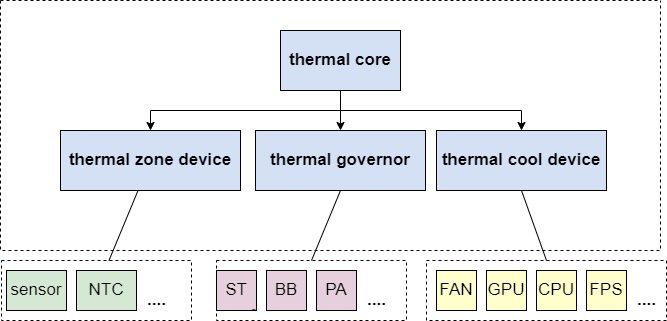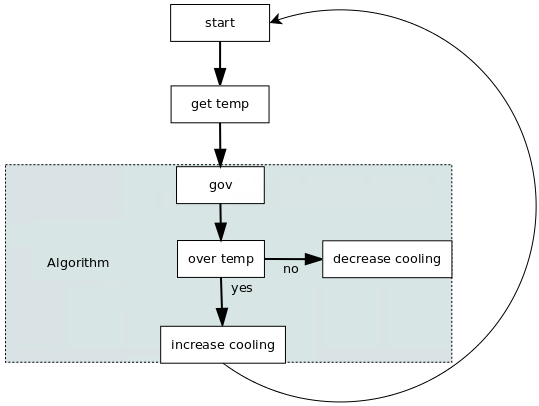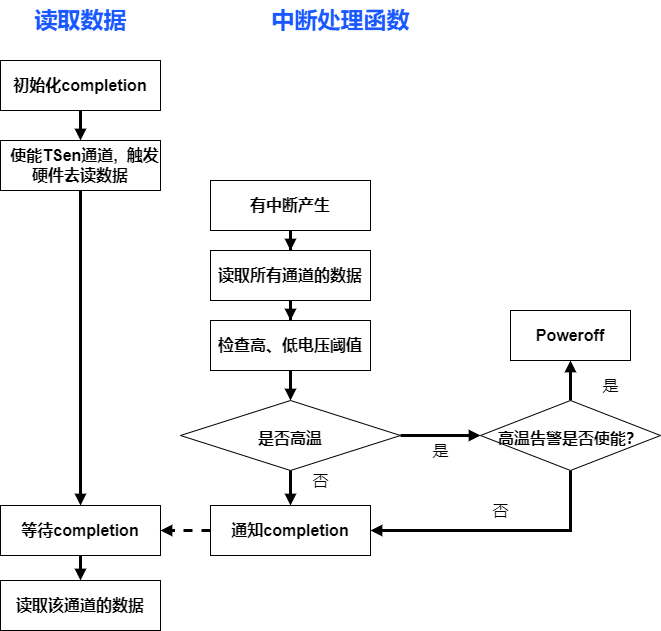TSensor 使用指南
1. 模块介绍
1.1. 术语定义
| 术语 | 定义 | 注释说明 |
|---|---|---|
| ADC | Analog Digital Converter | 模拟数字转换器 |
| ADCIM | ADC Interface Management | 模数转换管理模块 |
| TSensor/TSen | Thermal Sensor | 温度传感器 |
小技巧
TSensor 模块在�硬件 Spec 文档中也简称为 THS。
1.2. 模块简介
TSensor 需要依赖ADCIM模块(统一管理硬件通路和处理信号校准等),其关系如图:

图 4.12 TSensor 相关模块的硬件框图
TSensor 模块支持的特性有:
- 最多支持两路温度传感器,分别位于芯片内部的CPU位置、ADC位置
- 支持周期采样(周期间隔用户可定制)和非周期采样两种模式
- 每次采样的样本数量(1~8)可配置,然后取算术平均
- 支持高电平、低电平报警设置
- 支持过温保护(发生过温时硬件会触发看门狗重启)
- ADC与温度传感器捕获时间可配置
2. 参数配置
2.1. 内核配置
在luban根目录下执行 make kernel-menuconfig,进入kernel的功能配置,按如下选择:
Linux
Device Drivers
[*] Thermal drivers
<*> Artinchip thermal driver
2.2. DTS 参数配置
2.2.1. TSensor 自定义参数
TSensor 驱动支持从DTS中配置的自定义参数,如下表:
| 参数名称 | 类型 | 取值范围 | 功能说明 |
|---|---|---|---|
| aic,sample-period | 正整数 | > 0, (0, 10] | 周期采样模式下的周期值,单位:s |
| aic,high-temp-thd | 正整数 | > 0 | 高电平报警阈值 |
| aic,low-temp-thd | 正整数 | > 0 | 低电平报警阈值 |
| aic,htp-enable | boolean | 有 - 1,无 - 0 | 是否使能高温保护功能 |
注解
- 需在周期模式下,高/低电平报警以及高温保护功能才可使能有效
- 配置aic,htp-enable 时,需配置aic,high-temp-thd,否则高温保护使能无效
2.2.2. D211 配置
common/d211.dtsi中的参数配置:
tsen: tsen@19253000 {
compatible = "artinchip,aic-tsen-v1.0";
reg = <0x0 0x19253000 0x0 0x1000>;
interrupts-extended = <&plic0 94 IRQ_TYPE_LEVEL_HIGH>;
clocks = <&cmu CLK_TSEN>, <&cmu CLK_APB1>;
clock-names = "tsen", "pclk";
resets = <&rst RESET_TSEN>;
};
2.2.3. Board 配置
xxx/board.dts中的参数配置:
&tsen {
status = "okay";
tsen0 {
status = "okay";
};
tsen1 {
status = "okay";
};
};
小技巧
- 上述配置采样的是非周期模式;
- 几个阈值都没有配置,意味着相关功能没有打开;详见 TSensor 自定义参数
- 几个阈值都需要实测后才知道配置什么样的参数合适。
3. 调试指南
3.1. 调试开关
在luban根目录下执行 make kernel-menuconfig,进入kernel的功能配置,可以打开 TSensor 模块的DEBUG选项:
Linux
Kernel hacking
Artinchip Debug
[*] Thermal Sensor driver debug
此DEBUG选项打开的影响:
- TSensor 驱动以-O0编译
- TSensor 的pr_dbg()和dev_dbg()调试信息会被编译
在系统运行时,如果要打印pr_dbg()和dev_dbg()信息,还需要调整loglevel为8,两个方法:
- 在board.dts中修改bootargs,增加“loglevel=8”
- 在板子启动到Linux shell后,执行命令:
echo 8 > /proc/sys/kernel/printk
3.2. Sysfs 节点
3.2.1. 状态信息
在 TSensor 驱动初始化成功后,会在Sysfs中注册生成一个 status 节点,其中打印了当前的 TSensor 配置及状态信息:
# cat /sys/devices/platform/soc/19253000.tsen/status
In Thermal Sensor V1.00:
ch0: aic-tsen-cpu, Enable: 1, Value: 0
ch1: aic-tsen-adc, Enable: 1,Value: 0
3.2.2. 读取温度
Linux Thermal 子系统提供一些 Sysfs 节点,可以用来获取温度值等操作。
# cd /sys/class/thermal/
[aic@thermal] # ls
thermal_zone0 thermal_zone1
[aic@thermal] # cd thermal_zone0/
[aic@thermal_zone0] # ls
available_policies k_po policy type
hwmon0 k_pu slope uevent
integral_cutoff mode subsystem
k_d offset sustainable_power
k_i passive temp
[aic@thermal_zone0] # cat temp
0
[aic@thermal_zone0] # cat type
aic-tsen-cpu
4. 测试指南
4.1. 测试环境
4.1.1. 硬件
- 开发板,或D211的FPGA板
4.1.2. 软件
- PC端的串口终端软件,用于PC和开发板进行串口通信
4.2. 温度读取测试
温度数据的读取,只需要普通的cat命令即可,每次cat可读取某一个通道中的当前数据。详见 读取温度
5. 设计说明
5.1. 源码说明
源代码位于:drivers/thermal/artinchip_thermal.c
5.2. 模块架构
Linux内核中有一个Thermal子系统,代码目录见drivers/thermal,软件框架如下图:

图 4.13 Linux Thermal 子系统架构图
其中:
- zone device:获取温度的设备
- cool device:控制温度的设备,cool和zone可以设置bind关系。
- governor:控温策略
Thermal Core内部用一个delayed_work循环执行thermal_zone_device_update(),其流程如下:

图 4.14 Linux Thermal 子系统中的delayed_work处理流程
5.3. 关键流程设计
5.3.1. 初始化流程
TSensor模块完全遵循platform_driver的通用初始化流程,申请regs资源、clk、reset,另外需要使用Thermal子系统的注册接口thermal_zone_device_register()来注册zone设备。
struct thermal_zone_device *thermal_zone_device_register(const char *,
int, int, void *, struct thermal_zone_device_ops *,
struct thermal_zone_params *, int, int);
其中关键参数有:设备名称、zone设备的ops、以及私有数据等,ops中我们暂时只提供get_temp()接口的定义:
static struct thermal_zone_device_ops tsen_cpu_ops = {
.get_temp = tsen_cpu_get_temp,
};
static struct thermal_zone_device_ops tsen_adc_ops = {
.get_temp = tsen_adc_get_temp,
};
5.3.2. 中断处理流程
在中断处理函数中,可以通过私有数据来传递zone设备信息,从中获取到到该通道对应的寄存器基地址,就可以读到相应的报警状态。
TSensor 支持使用中断方式来读取数据,这样避免软件去做等待处理。

图 4.15 TSensor 非周期模式的数据采集流程
- 对于非周期模式:当用户层触发 ops->get_temp() 接口,就会启动一次硬件去读数据
- 当硬件准备好数据,会产生一个中断
- 在中断处理函数中,用INT Flag来区分是哪个通道有数据,逐个通道扫描将数据读出,会缓存到一个全局变量中
- 对于周期模式:TSensor 控制器会自动按给定周期产生一次数据中断
注解
- TODO:需要针对不同类型的报警状态,增加相应的处理。
- 当前默认�高温保护为poweroff,可修改高温保护行为。
5.4. 数据结构设计
5.4.1. aic_tsen_dev
管理TSensor控制器的设备资源:
struct aic_tsen_dev {
struct attribute_group attrs;
void __iomem *regs;
struct platform_device *pdev;
struct clk *clk;
struct reset_control *rst;
u32 pclk_rate;
u32 irq;
u32 ch_num;
struct aic_tsen_ch chan[AIC_TSEN_MAX_CH];
};
5.5. 接口设计
以下接口提供给 Linux Thermal 子系统调用的标准接口。
5.5.1. tsen_cpu_get_temp
| 函数原型 | static inline int tsen_cpu_get_temp(struct thermal_zone_device *thermal, int *temp) |
|---|---|
| 功能说明 | 读取CPU位置处的sensor温度数据 |
| 参数定义 | thermal - 指向thermal zone设备temp - 用来保存读取到的温度 |
| 返回值 | 0,成功 |
| 注意事项 |
5.5.2. tsen_adc_get_temp
| 函数原型 | static inline int tsen_adc_get_temp(struct thermal_zone_device *thermal, int *temp) |
|---|---|
| 功能说明 | 读取ADC位置处的sensor温度数据 |
| 参数定义 | thermal - 指向thermal zone设备temp - 用来保存读取到的温度 |
| 返回值 | 0,成功 |
| 注意事项 |
6. 常见问题
6.1. 关于温度值的精度
硬件采集到的温度值需要先经过一个转换算法,才会得到一个类似生活中常见的温度值。此转换算法的精度一般采用的是 线性拟合方法,存在一定的误差。
6.2. 关于告警的阈值
- 高温、低温、过温阈值的选择,需要基于大量板子的实测数据,并结合用户场景需求来选定。
- 当配置了过温告警后,一旦温度达到过温阈值,IC硬件会自动触发CPU的复位,软件无需参与也无法参与。
注解
通常达到了高温阈值,会触发CPU降频等类似的降低系统性能处理,目前D211的动态降频功能暂未验证。